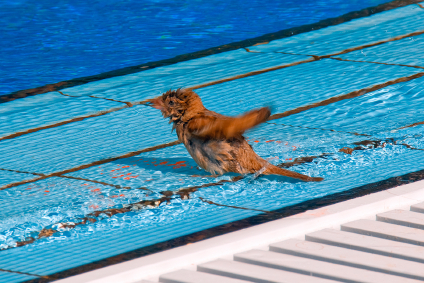
Geese, ducks, pigeons, sparrows and other birds often use pools and spas for drinking, pruning and cooling off. But bird droppings in and around pool areas are unsanitary and can pose a health hazard. Birds can carry any of 60 known diseases.
Germs in bird droppings can infect humans. Duck and goose droppings, for example, may contain germs such as E. coli, Salmonella, Campylobacter, or Cryptosporidium ("Crypto" for short). While chlorine will normally kill most germs in bird droppings, the germ Crypto is protected by a tough outer shell. This shell allows it to survive for days even in a chlorinated pool.
There’s also the slip-and-fall hazards wet bird droppings can create. Children running around pools can easily fall and injure themselves. Bird droppings on lounge chairs and towels can be equally unsettling.
This brings up the daily maintenance required when pest birds have invaded your pool or spa area. There’s the constant cleaning and monitoring of water content, the daily hosing off of deck chairs, tables and walkways—with pest birds, this process never ends.
Getting rid of pest birds can be a challenge. In the US, most birds, including ducks and geese, are protected by the Federal Migratory Bird Treaty Act as well as by some state and local laws. This rules out lethal or harmful bird deterrents such as poisons, pellet guns or damaging or moving nests.
Here are some suggestions to keep pest birds away form your pool and spa area:
Scarecrows
A natural around pools and spas, Scarecrows employ a motion-activated sensor to detect any bird entering a pre-set radius of protection. Once activated, birds get doused with a spray of water. Scarecrows connect easily to any standard garden hose and will protect a 1,200 square feet area (or a 35-foot by 45-foot wide swath). You can easily adjust the sensitivity and blast radius to you specific needs. And one 9-volt battery powers the entire device.
Sonic Bird Deterrents
Birds are always on the alert for predators. Sonic Bird Deterrents exploit this fact, emitting pre-recorded distress and predator calls that prompt birds to leave. If your pool or spa areas is being invaded by a swarm of mixed bird species, consider getting the Bird Chase Super Sonic. It’s ideal for most common pest birds, including pigeons, crows and gulls. In fact, it emits distress and predator calls for 22 different species of birds.
Red-Tail Hawk Decoys
These look decorative and they work to scare most birds away. Red-Tail Hawk Decoys make the perfect companion bird deterrent for the two listed above. Just make sure you get the most realistic looking decoy available. The best hawk decoys are made of heavy duty plastic and will last for many seasons outdoors. The only thing you have to remember about hawk decoys is to re-position them from time to time.
